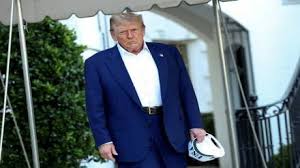Trump pressures Congress on his ‘big beautiful bill’ as debate clouds path forward

Former President Donald Trump is once again asserting his influence over Capitol Hill, this time pushing lawmakers to back what he calls his “big beautiful bill.” While Trump remains coy about the specific legislative details, the branding is familiar — evocative, grandiose, and aimed squarely at his political base. Yet, despite the fanfare, the proposal is mired in controversy, with both chambers of Congress sharply divided over its content and purpose.
The bill, reportedly a sweeping package aimed at overhauling immigration laws, border security, and economic incentives for American workers, has sparked a political firestorm. Trump, now the presumptive Republican nominee for 2024, is using his platform to rally support for the measure, framing it as a test of political loyalty and policy vision.
A Familiar Strategy, A New Political Stage
Trump’s legislative push is reminiscent of his 2016 campaign strategies, where messaging often outweighed policy specifics. During a recent rally in Pennsylvania, Trump proclaimed, “This is the most beautiful piece of legislation ever crafted for the American people. It’s going to secure the border, grow the economy, and finally put Americans first — big, beautiful, and bold.”
However, critics argue that the proposal lacks transparency. Drafts of the bill, which remain largely undisclosed to the public, have been circulated among key Republican figures but not released to the broader legislative body. Democrats and some centrist Republicans are demanding a full review before any floor debate can commence.
Immigration and Border Security at the Core
Central to Trump’s pitch is border security — an issue that has consistently mobilized his base. The bill allegedly includes funding for completing the border wall, increasing ICE enforcement powers, and limiting asylum claims. These provisions have drawn strong opposition from Democrats and immigrant advocacy groups, who label the bill as “draconian and xenophobic.”
Senate Majority Leader Chuck Schumer criticized the approach: “Once again, we are seeing more political theater than policy. If this is a genuine legislative effort, why isn’t the full text public? Why are we being asked to trust branding over substance?”
Republicans, for their part, are divided. While hardliners like Rep. Marjorie Taylor Greene and Sen. Josh Hawley have embraced the proposal, others are wary of backing a bill that may hurt their reelection bids in competitive districts.
Economic Promises and Political Risks
Trump’s allies argue that the bill includes significant tax incentives for businesses that hire American workers and tougher penalties for outsourcing. These measures are being packaged as part of an “America First” economic revival. However, economists are skeptical about the long-term impact, warning that such provisions could strain international trade relations and lead to higher costs for consumers.
Former White House economic advisor Kevin Hassett, in a recent interview, said, “There’s political appeal in protectionism, but the details of implementation matter. We haven’t seen those details yet. That’s a red flag.”
Meanwhile, business groups such as the U.S. Chamber of Commerce have raised concerns about the bill’s restrictive visa policies, arguing they could hamper innovation and workforce development.
Congressional Stalemate and Uncertain Path Forward
As the bill enters the early stages of committee review, its future remains unclear. The House Judiciary Committee is expected to hold preliminary hearings later this week, but no firm timeline for a floor vote has been announced. House Speaker Mike Johnson has indicated cautious support, saying, “The bill reflects many priorities we’ve discussed, but we need to ensure it’s viable and constitutional.”
Across the aisle, Democrats are preparing a counterproposal focused on immigration reform, legal pathways, and enhanced humanitarian aid. President Biden has not commented directly on Trump’s bill, but White House Press Secretary Karine Jean-Pierre noted, “We are monitoring the situation and urge Congress to prioritize real, bipartisan solutions.”
Trump’s Political Calculus
Trump’s push comes at a critical moment in the 2024 campaign. With polls tightening and Trump facing multiple legal challenges, he is looking to reassert control over the national narrative. His promotion of the “big beautiful bill” serves multiple purposes: energizing his base, dominating media coverage, and pressuring congressional Republicans to align publicly with his platform.
Analysts suggest that Trump’s timing is strategic. “He’s trying to box in congressional Republicans,” says political strategist Amy Walter. “If they oppose the bill, they risk alienating his base. If they support it, they could lose moderates. It’s a classic Trump move — force a loyalty test.”
Public Reaction Mixed
Public opinion remains sharply divided. A recent YouGov poll showed 47% of Republicans supporting Trump’s bill sight unseen, while 61% of Democrats oppose it strongly. Among independents, 52% said they needed more information before forming an opinion.
Civil society organizations, including the ACLU and Human Rights Watch, have vowed to mobilize against the bill if it advances. On social media, hashtags like #BigBeautifulMess and #TrumpBillDebate are trending, reflecting the polarized discourse surrounding the proposal.
Conclusion
Donald Trump’s “big beautiful bill” has injected new drama into the congressional landscape. With political stakes high and legislative clarity low, the coming weeks could determine whether this bill becomes a signature Trump-era policy or fizzles out in partisan gridlock. For now, it’s clear that the road ahead is anything but beautiful — and certainly not smooth.






